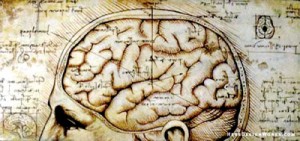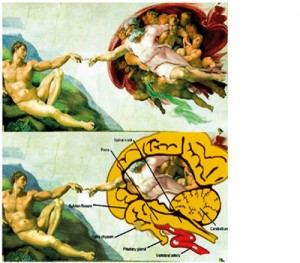Sunday Times 2
Neurology: Straining every nerve for its progress
View(s):of Medicine lecture series at the Sri Lanka Medical Association (SLMA)

Da Vinci's depictopn of the human brain (1452-1519)
Neurology was born with the origin of the human nervous system. However, all animals have a nervous system for detecting and identifying suitable food and early detection of threats and remedial action. It took millions of years for the complex human nervous system to develop.
It was Hippocrates, living in the Greek island of Kos around 400 BC, who established medicine as a discipline and said that diseases were caused ânaturallyâ and not by spirits and supernatural forces. He linked epilepsy to the brain and also described a stroke as âapoplexyâ. However, about 100 years before Hippocrates, Lord Buddha, debarred men and women with epilepsy from becoming monks.
However, Michelangelo (living around the same time), at 17 years dissected corpses from the church graveyard and documented anatomy by painting. It was assumed that his paintings were destroyed. However, between the years 1508 and 1512 he painted the ceiling of the Sistine Chapel in Rome. Now 500 years after he drew them, his hidden anatomical illustrations have been found-painted on the ceiling of the Sistine Chapel, in the Vatican, cleverly concealed from the eyes of Pope Julius II.

n Michelangelo surrounded God with a shroud representing the human brain to suggest that âGodâ was endowing Adam not only with life, but also with a brain â seat of supreme human intelligence n Researchers have found a precise and accurate depiction of the human spinal cord, brain stem, eyes and optic nerve of man inside the figure of âGodâ directly above the altar.
The vertebrate nervous system
In vertebrates, from fish to frog, to reptile and birds there was differential development depending on priority needs, e.g.
(1)Â Olfactory lobes well developed – to smell prey and danger
(2)Â Optic lobes well developed – to see prey and avoid danger
(3)Â Cerebellum for balance – directional motion
In vertebrates, what really matters is the brainâs size in relation to body size. The ratio is 1.9 in humans and the nearest ratio to humans is the rat at 1.3. Explains why we do experiments on rats and why they out smart humans at times. I do not know the figures for mosquitos!
World scene in relation to history of neurology
Thomas Willis, an Englishman, was the first to use the word “neurologyâ, in 1664. The separation of psychiatry and neurology was also in Great Britain.
The first President of ABN, Sir Hughlings Jackson, described a form of epilepsy which showed a march of convulsions identical, with the representation of the body in the cerebral cortex. (Jacksonian epilepsy)
Dr. S.A. Cabraal was the first neurosurgeon and Dr. G.S. Ratnavale the first neurologist.
The Neuro Surgical Unit (NSU) occupied the whole of the 4th floor of the new impressive Bandaranaike building of the then General Hospital, Colombo. The NSU suite on the 4th floor not only had male and female units but also an operating theatre, intensive care unit, a neuroradiology unit and physiotherapy unit.
Though there was no stroke unit, patients with strokes were well cared for by a multidisciplinary team with the team consisting of the neurologist, two nurses, two physiotherapists, a dietician with discussion by the bedside with the patient and a care giver, often a relative of the patient who would continue the care after the patient was discharged. Unfortunately, the medical neurology unit was dependent on the surgical unit for investigations like EEG, angiography and myelography. There were no CT scans or MRI scans till the 1980s.
The funding was organized by a small committee which met every week for four years under the auspices of the hospital welfare services of the All Ceylon Buddhist Congress (ACBC) and the construction managed and overseen by design consortium and project management services, all on a voluntary basis. The institute was opened in 1984 and continues to provide care to neurology patients.

